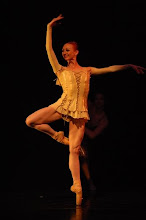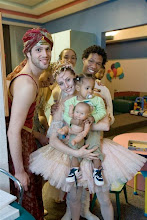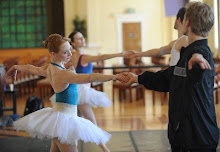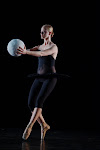World Enough and Time....Why I don't believe ballet is over part II. (To read part I, click here)
As one of only 4 women leading ballet companies of a certain size and capability, I realized I had no desire to find "the next Balanchine", not because I didn't respect and admire his profound influence and gifts, but because I felt that looking for the next Balanchine was once again looking for an outside male savior, in many respects. It just doesn't seem like the right attitude. If women in the ballet world had been taught to find their own answers, I suspect there would be more of us making choreography and running ballet companies than there currently are. Furthermore, I was seeing a lot of lack-luster imitative choreography, coupled with a lot of steps that had no discernible meaning. It was time to help find ways to guide choreographers and dancers toward discovering meaning. If they understood and looked for meaning, perhaps they could pair their creations and their steps with renewed commitment to what lies at the base of our desire to be artists engaged in expressive dialogue.
As leaders in our field, artistic directors need to understand that the world around us, which we ask be reflected by our dancers and choreographers, is one full of possibilities. Take the stage as our setting, our metaphor. We can provide a place of almost limitless exploration because space is a gift we are honored to have time to fill while we walk, or dance, on this earth. Fill it how? With what theme? What questions? What sorrows and joys? What hopes? Isn't that how we want all human beings to move in the world? With questions, with delight, searching alone and together in community, in order to fill our world and time with value and meaning? If the flatness of the screen is affecting the thinking of people across our world, can we not call out to them and say "Look here! There is depth, intricacy, boldness! We illuminate space with our patterns and partnerships. There is room for so many. We work together, with dignity and respect for one another, and for the space in which we temporarily reside." Honestly, why don't we think of ourselves as ecologists of the human spirit?
There are other places in our country where people in our field are starting to address the need for change in the ballet world. It is very much still a patriarchal world, and the change is not really starting with the "big boys" in the big cities. This is understandable. The large cities of our nation have enough density and wealth to keep supporting, at least a while longer, what Ms. Homans sees and finds so discouraging. Those of us who live in closer proximity to the nation's "not so beautiful" know that these very people, these outliers, are often the ones whose voices, when heard, transform art. We need to closely read what is being written, hear what is being sung, experience what moves our population, and we can open a curtain behind which I believe we will find a vastness and potential we have long ignored. Furthermore, it is by seeing what we may not want to see, what we may not understand or be comfortable with, that we learn more about who we are as individuals and as people in relationship with others.
Ballet Memphis has re-enlivened story ballets and put dances in thematic context in our programming. We have investigated fused movement and local music and regional literature. We have done this without turning our backs on our training and our belief in what Ms Homans so eloquently calls our "inner truth and elevated state of being." I completely agree with her that there has been , in so many places, a forsaking of our sense of our capacity for transformation of the human spirit and our losing sight of what I believe is the enormous potential of human beings moving in the world together. However, I do not believe that this state has come about consciously. We reflect what we learn in our world. If it has become one of stricture, and of fear which blinds us, then our hope lies in our ability to reach a point where we can see what those blinders are and begin the challenging task of removing them.
We must become more conscious creators of dance. We must structure our companies and classrooms in ways that welcome "outsiders", in ways that guide and empower our young artists so that they do not feel they must conform to a structure run by a king, even if he is a benevolent despot. We must encourage curiosity and respect simultaneously, and model what is worthy of respect. We can encourage curiosity, thoughtfulness, tolerance, and give our emerging artists and audiences the understanding that they are not a part of an isolated fairy kingdom, but are a part of a world to which they can contribute hope, inspiration, and a meaningful context for exploration of ideas, experiences, and relationships. Ballet can awaken the sparkling spirit of a mysterious kingdom better than any art form I can think of, but this kingdom provides us a glimpse into attributes we share as humans that propel us forward together in a vast and ever-changing , often exciting, world. If we lose sight of why we dream about and create worlds of beauty, we stay lost in the mist.
I work in a ballet company that is truly alive. I think there are more of us out there. If we are singular, ( and I don't think we are,) we don't have to be. If the sparks are buried, I don't think they are yet suffocated. I have enormous hope. We need an awakened leadership that helps our artists, giving them the opportunity to see that "world enough and time" awaits their unselfish love , talent, and commitment to meaningful creation.
Monday, November 8, 2010
Monday, November 1, 2010
World Enough and Time
World Enough and Time....Why I don't believe ballet is over
I have often felt a small tinge of alarm when I hear the word "like" which has crept into the vocabulary of our young, and into many older generations' speech as well. Jenifer Homans, in her article "Is Ballet Over?", speaks of today's ballet artists "not quite committing" as they dance. The word "like" is often inserted before a verb, as in "we were like hoping," " we were like thinking,", or "I was kinda like going this way..." If we accept the premise that there is probably a problem of commitment here, a fear of embracing action, and apply it toward the art of ballet, perhaps we can engage in a conversation about what we actually want to be committed to in the ballet world.
Some years ago, as a founding artistic director of a ballet company in a mid-sized city in the fly-over zone, I began asking questions about our purpose in the rapidly changing democracy in which we live and work and create art. What values do we hold that resonate in this world? How do we open our ballet world of idealistic hope and belief to others? How do we listen to what others say, and then nurture and create art and artists as members of a world, not a narrow kingdom? In ballet's history, artists who left the European capitals often returned with a greater understanding of what people bring to dance. I think particularly of the great Danish choreographer Auguste Bournonville (check spelling of both names please!) . By being attentive to other cultures and classes, he brought a recognizably human embrace to the ballet stage.
In a city like Memphis, with enormous social challenges and a culture so clearly enriched and influenced by black America, I have never felt that the white European aristocratic model was one in which we need to imprison ourselves. Neither did George Balanchine, as Ms. Homans points out so well. Exploring what others have to offer can broaden our language.
I have often felt a small tinge of alarm when I hear the word "like" which has crept into the vocabulary of our young, and into many older generations' speech as well. Jenifer Homans, in her article "Is Ballet Over?", speaks of today's ballet artists "not quite committing" as they dance. The word "like" is often inserted before a verb, as in "we were like hoping," " we were like thinking,", or "I was kinda like going this way..." If we accept the premise that there is probably a problem of commitment here, a fear of embracing action, and apply it toward the art of ballet, perhaps we can engage in a conversation about what we actually want to be committed to in the ballet world.
Some years ago, as a founding artistic director of a ballet company in a mid-sized city in the fly-over zone, I began asking questions about our purpose in the rapidly changing democracy in which we live and work and create art. What values do we hold that resonate in this world? How do we open our ballet world of idealistic hope and belief to others? How do we listen to what others say, and then nurture and create art and artists as members of a world, not a narrow kingdom? In ballet's history, artists who left the European capitals often returned with a greater understanding of what people bring to dance. I think particularly of the great Danish choreographer Auguste Bournonville (check spelling of both names please!) . By being attentive to other cultures and classes, he brought a recognizably human embrace to the ballet stage.
In a city like Memphis, with enormous social challenges and a culture so clearly enriched and influenced by black America, I have never felt that the white European aristocratic model was one in which we need to imprison ourselves. Neither did George Balanchine, as Ms. Homans points out so well. Exploring what others have to offer can broaden our language.
Subscribe to:
Posts (Atom)











